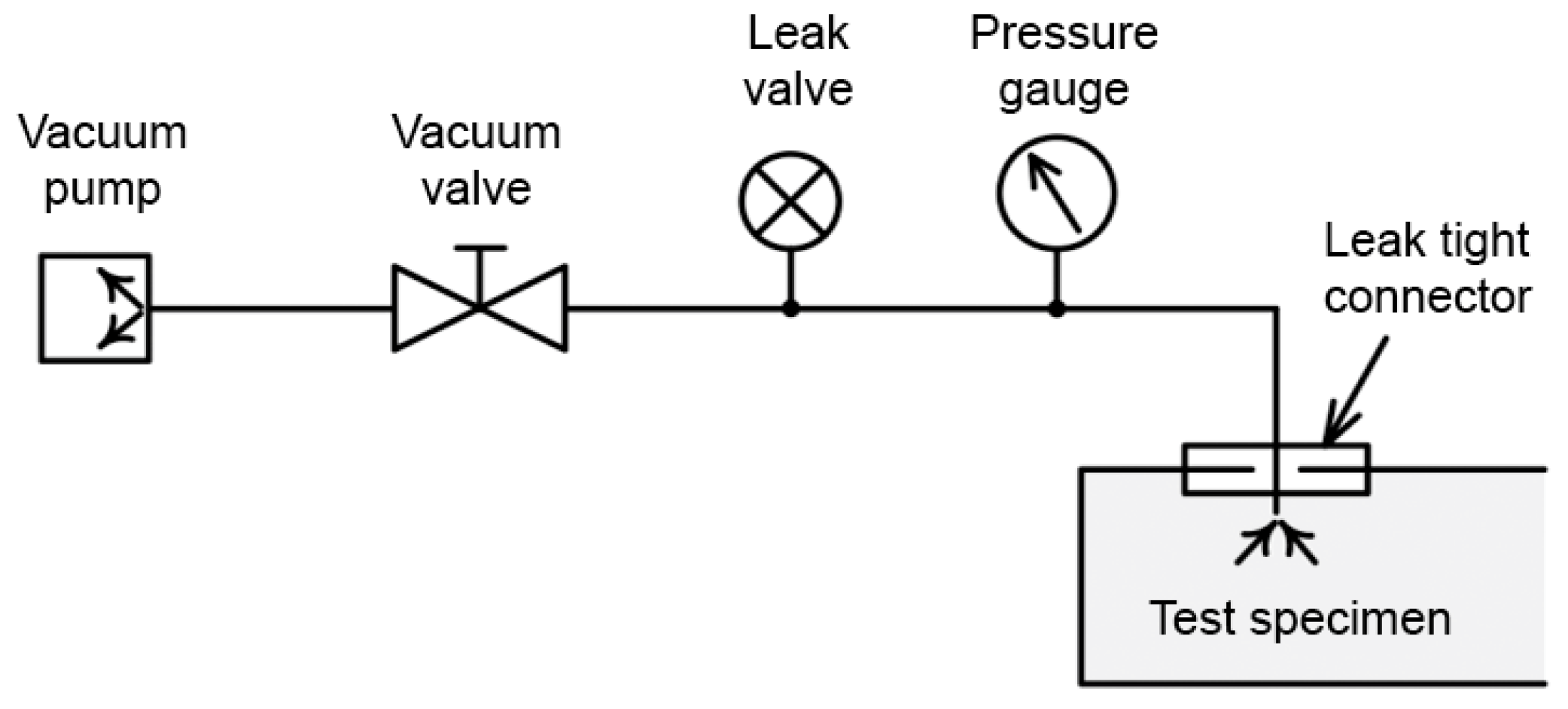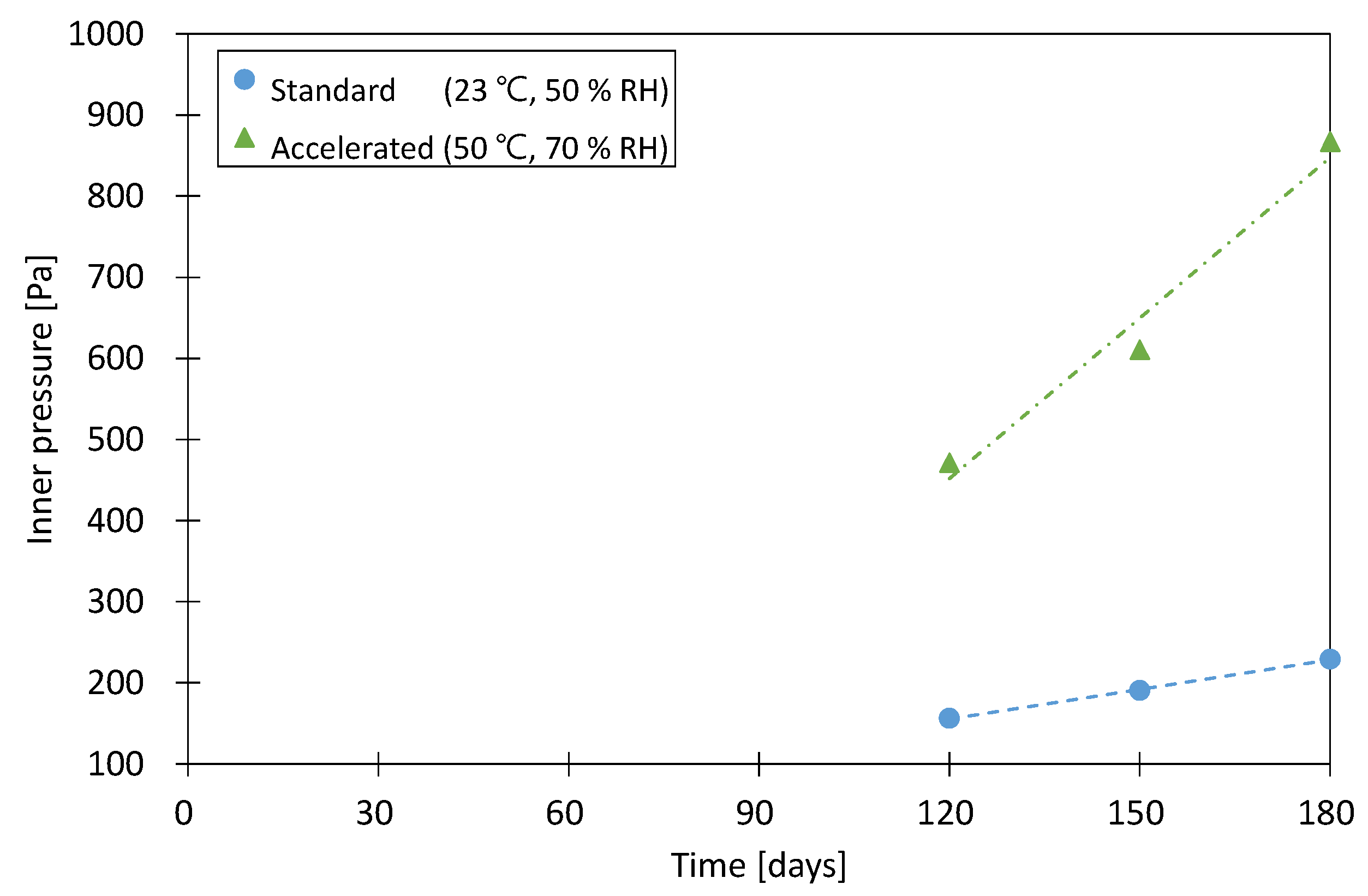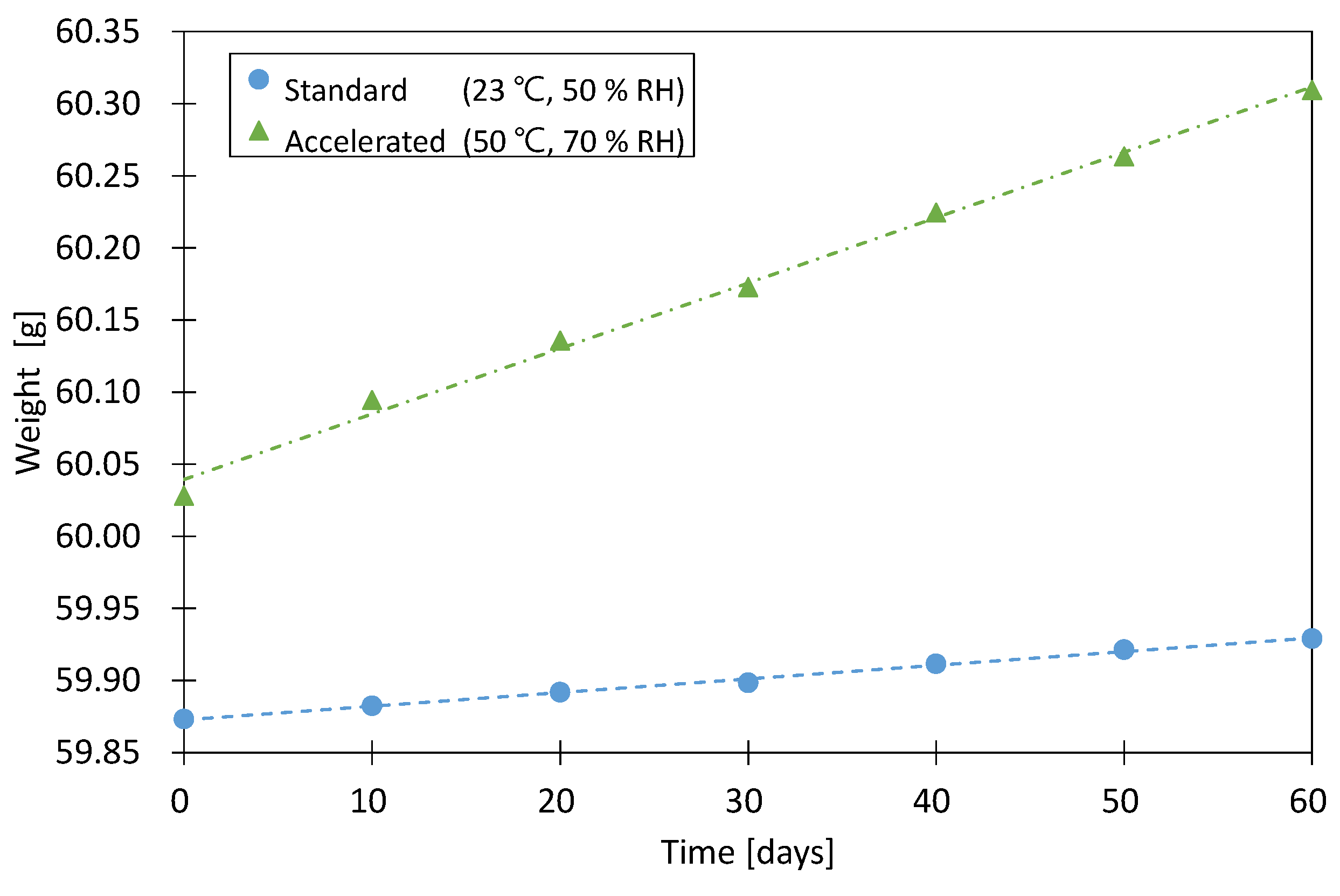Development of Accelerated Test Method to Evaluate the Long-Term Thermal Performance of Fumed-Silica Vacuum Insulation Panels Using Accelerated Conditions
Abstract
:1. Introduction
2. Materials and Methods
2.1. Sample Preparation
2.2. Methodology
2.2.1. Thermal Conductivity and Inner-Pressure Test of Fumed-Silica VIP
2.2.2. Permeation Test on the VIP Envelope
2.2.3. Conditioning under Accelerated and Standard Conditions
2.2.4. Estimating the Thermal Conductivity of VIP after 25 Years
3. Results and Discussion
3.1. Correlation between Thermal Conductivity and Inner Pressure
3.2. Permeation Test on the VIP Envelope
3.3. Conditioning under Accelerated and Standard Conditions
3.3.1. Determination of the Conditioning Period for Highly Accelerated Conditions
3.3.2. Inner-Pressure Increase Rate under Accelerated and Standard Conditions
3.4. Estimating the Thermal Performance of VIP after 25 Years
3.4.1. Under Highly Accelerated Conditions
3.4.2. Under Accelerated Conditions
3.4.3. No Acceleration (under Standard Condition)
3.4.4. Comparing with the Estimated Thermal Performance of VIP after 25 Years
- Relationship between thermal conductivity and the inner pressure;
- Acceleration factor for dry air and water vapor of the envelope.
4. Conclusions
- According to the calculation, the results of conditioning for 180 days under 50 °C and 70% RH and those for 62.7 days under 80 °C and 70% RH would match. Based on the test results, the inner-pressure increase rate of samples for 60–70 days after conditioning under 80 °C and 70% RH and that of samples for 60–180 days after conditioning under 50 °C and 70% RH are similar.
- When estimated by the acceleration test procedure using highly accelerated conditions, the long-term thermal performance was 0.0076 W/m·K, and the thermal performance was deteriorated about 62% compared to the initial thermal conductivity. Using acceleration conditions with the same method, the long-term thermal performance was 0.0054 W/m·K, and the thermal performance was deteriorated about 59% compared to the initial thermal conductivity.
- These results satisfied the minimum standards for a VIP (less than 0.0100 W/m·K, more than 0.8 m2·K/W) specified in ISO/DIS 16478. Additionally, there was a similarity between the two long-term thermal performances using the highly accelerated conditions of 80 °C and 70% RH and the accelerated conditions of 50 °C and 70% RH. In the accelerated test method, conditioning for 70 days using highly accelerated conditions can achieve similar results to conditioning for 180 days under accelerated conditions.
- Evaluating the long-term thermal performance of a VIP using the accelerated test method discussed in this study is only applicable to a fumed-silica VIP. Additionally, the following subtests should be conducted before the accelerated test: relationship between thermal conductivity and the inner pressure; acceleration factor for dry air and water vapor of the envelope.
- The core material and barrier envelope used in these subtests are equal to the specimen conditioned using highly accelerated conditions. In particular, the width, length, and thickness of the specimen used to analyze the relationship between thermal conductivity and inner pressure should be the same as the fumed-silica VIP product to be evaluated by the accelerated test method.
Author Contributions
Funding
Institutional Review Board Statement
Informed Consent Statement
Data Availability Statement
Conflicts of Interest
References
- Johansson, P.; Geving, S.; Hagentoft, C.E.; Jelle, B.P.; Rognvik, E.; Kalagasidis, A.S.; Time, B. Interior insulation retrofit of a historical brick wall using vacuum insulation panels: Hygrothermal numerical simulations and laboratory investigations. Build. Environ. 2014, 79, 31–45. [Google Scholar] [CrossRef]
- Gonçalves, M.; Simões, N.; Serra, C.; Flores-Colen, I. A review of the challenges posed by the use of vacuum panels in external insulation finishing systems. Appl. Energy 2020, 257, 114028. [Google Scholar] [CrossRef]
- Baetens, R.; Jelle, B.P.; Thue, J.V.; Tenpierik, M.J.; Grynning, S.; Uvsløkk, S.; Gustavsen, A. Vacuum insulation panels for building applications: A review and beyond. Energy Build. 2010, 42, 147–172. [Google Scholar] [CrossRef]
- Mukhopadhyaya, P.; Kumaran, K.; Normandin, N.; Reenen, D.; Lackey, J. High-Performance Vacuum Insulation Panel: Development of alternative core materials. J. Cold Reg. Eng. 2008, 22, 103–123. [Google Scholar] [CrossRef]
- Yeo, I.; Jung, H.; Song, T.H. Gas permeation characteristics through heat-sealed flanges of vacuum insulation panels. Vacuum 2014, 104, 70–76. [Google Scholar] [CrossRef]
- Jung, H.; Jang, C.H.; Yeo, I.S.; Song, T.H. Investigation of gas permeation through Al-metallized film for vacuum insulation panels. Int. J. Heat Mass Transf. 2013, 56, 436–446. [Google Scholar] [CrossRef]
- Boafo, F.E.; Chen, Z.; Li, C.; Li, B.; Xu, T. Structure of vacuum insulation panel in building system. Energy Build. 2014, 85, 644–653. [Google Scholar] [CrossRef]
- Porta, P. Gas problem and gettering in sealed-off vacuum devices. Vacuum 1996, 47, 771–777. [Google Scholar] [CrossRef]
- Kan, A.; Zheng, N.; Wu, Y.; Wang, W.; Zhang, X.; Cai, H.; Cao, D. Theoretical prediction and aging experimental verification of the service life of vacuum insulation panels. Clean. Eng. Technol. 2022, 8, 100484. [Google Scholar] [CrossRef]
- Alam; Singh, H.; Suresh, S.; Redpath, D.A.G. Energy and economic analysis of Vacuum Insulation Panels (VIPs) used in non-domestic buildings. Appl. Energy 2017, 188, 1–8. [Google Scholar] [CrossRef]
- Uriarte, A.; Garai, I.; Ferdinando, A.; Erkoreka, A.; Nicolas, O.; Barreiro, E. Vacuum insulation panels in construction solutions for energy efficient retrofitting of buildings. Two case studies in Spain and Sweden. Energy Build. 2019, 197, 131–139. [Google Scholar] [CrossRef]
- Wegger, E.; Jelle, B.P.; Sveipe, E.; Grynning, S.; Gustavsen, A.; Baetens, R.; Thue, J.V. Aging effects on thermal properties and service life of vacuum insulation panels. J. Build. Phys. 2011, 35, 128–167. [Google Scholar] [CrossRef]
- Simmler, H.; Brunner, S. Vacuum insulation panels for building application. Energy Build. 2005, 37, 1122–1131. [Google Scholar] [CrossRef]
- Batard, A.; Duforestel, T.; Flandin, L.; Yrieix, B. Modelling of long-term hygro-thermal behaviour of vacuum insulation panels. Energy Build. 2018, 173, 252–267. [Google Scholar] [CrossRef]
- Pons, E.; Yrieix, B.; Heymans, L.; Dubelley, F.; Planes, E. Permeation of water vapor through high performance laminates for VIPs and physical characterization of sorption and diffusion phenomena. Energy Build. 2014, 85, 604–616. [Google Scholar] [CrossRef]
- Pons, E.; Yrieix, B.; Brunner, S. Evaluation of VIPs after mild artificial aging during 10 years: Focus on the core behavior. Energy Build. 2018, 162, 198–207. [Google Scholar] [CrossRef]
- Batard, A.; Duforestel, T.; Flandin, L.; Yrieix, B. Prediction method of the long-term thermal performance of Vacuum Insulation Panels installed in building thermal insulation applications. Energy Build. 2018, 178, 1–10. [Google Scholar] [CrossRef]
- Schwab, H.; Heinemann, U.; Beck, A.; Ebert, H.P.; Fricke, J. Permeation of Different Gases through Foils used as Envelopes for Vacuum Insulation Panels. J. Therm. Envel. Build. Sci. 2005, 28, 293–317. [Google Scholar] [CrossRef]
- Mao, S.; Kan, A.; Zhu, W.; Yuan, W. The impact of vacuum degree and barrier envelope on thermal property and service life of vacuum insulation panels. Energy Build. 2020, 209, 109699. [Google Scholar] [CrossRef]
- Kim, J.H.; Boafo, F.E.; Kim, S.M.; Kim, J.T. Aging performance evaluation of vacuum insulation panel (VIP). Case Stud. Constr. Mater. 2017, 7, 329–335. [Google Scholar] [CrossRef]
- IEA/ECBCS Annex 39, Vacuum Insulation Panels—Study on VIP-Components and Panels for Service Life Prediction of VIP in Building Applications (Subtask A). 2005. Available online: https://www.osti.gov/etdeweb/biblio/21131463 (accessed on 22 August 2023).
- Johansson, P.; Adl-Zarrabi, B.; Kalagasidis, A.S. Evaluation of 5 years’ performance of VIPs in a retrofitted building façade. Energy Build. 2016, 130, 488–494. [Google Scholar] [CrossRef]
- Molleti, S.; Lefebvre, D.; Reenen, D. Long-term in-situ assessment of vacuum insulation panels for integration into roofing systems: Five years of field-performance. Energy Build. 2018, 168, 97–105. [Google Scholar] [CrossRef]
- Masi, R.F.D.; Ruggiero, S.; Vanoli, G.P. Multi-layered wall with vacuum insulation panels: Results of 5-years in-field monitoring and numerical analysis of aging effect on building consumptions. Appl. Energy 2020, 278, 115605. [Google Scholar] [CrossRef]
- EN 17140; Thermal Insulation Products for Buildings—Factory-Made Vacuum Insulation Panels (VIP)—Specification. European Committee for Standardization: Brussels, Belgium, 2020.
- JIS A 1488; Test Method for Long Term Change in Apparent Thermal Conductivity of Vacuum Insulation Panels for Buildings. Japanese Industrial Standard Committee: Tokyo, Japan, 2020.
- ISO/TC 163/SC 03-16478; Thermal Insulation Products for Buildings―Vacuum Insulation Panels (VIP)―Products Specification. ISO: Geneva, Switzerland, 2018.
- Murphy, C.J.; Woodward, P.M.; Bursten, B.E. Chemistry: The Central Science, 12th ed.; Pearson Education Limited: London, UK, 2014. [Google Scholar]
- Korea Agency for Technology and Standards. KS L 9016 Test Methods for Thermal Transmission Properties of Thermal Insulations. 2010. Available online: https://standard.go.kr/KSCI/standardIntro/getStandardSearchView.do?menuId=919&topMenuId=502&upperMenuId=503&ksNo=KSL9016&tmprKsNo=KSL9016&reformNo=05 (accessed on 22 August 2023).






| Classification | Thermal Resistance [m2·K/W] | Thermal Conductivity [W/m·K] |
|---|---|---|
| Initial value of center of panel () | >1.6 | <0.0050 |
| Initial value including thermal bridging () | - | Declare |
| Aged value of center of panel () | >0.8 | <0.0100 |
| Aged value including thermal bridging () | - | Declare |
| Pressure [Pa] | Thermal Conductivity [W/m·K] |
|---|---|
| 10 | 0.0034 |
| 59 | 0.0034 |
| 98.4 | 0.0035 |
| 960 | 0.0041 |
| 10,000 | 0.0095 |
| Symbol | Unit | Accelerated Conditions | |
|---|---|---|---|
| 80 °C and 70% RH | 50 °C and 70% RH | ||
| W/m·K | 0.0047 | 0.0034 | |
| W/m·K | 0.026 | 0.026 | |
| Pa | 58,343 | 58,343 | |
| W/m·K·Pa | 4.46 × 10−7 | 4.46 × 10−7 | |
| W/m·K·s | 2.04 × 10−10 | - | |
| W/m·K·s | - | 1.90 × 10−11 | |
| W/m·K·s | 0.0062 | 0.0043 | |
| W/m·K | 0.0047 | 0.0034 | |
| - | 26.0 | 5.4 | |
| - | 12.9 | 4.5 | |
| W/m·K·s | 3.49 × 10−12 | 2.90 × 10−12 | |
| Service life | years | 25 | 25 |
| W/m·K | 0.0030 | 0.0021 | |
| W/m·K | 0.0076 | 0.0054 | |
| Criteria | Thermal Conductivity [W/m·K] | Thermal Resistance [m2·K/W] | |||
|---|---|---|---|---|---|
| Initial | Aged | Initial | Aged | ||
| <0.0050 | <0.0100 | >1.6 | >0.8 | ||
| Test condition | Highly accelerated | 0.0047 | 0.0076 | 2.13 | 1.32 |
| Accelerated | 0.0034 | 0.0054 | 2.94 | 1.85 | |
| Not accelerated | 0.0036 | 0.0040 | 2.78 | 2.50 | |
Disclaimer/Publisher’s Note: The statements, opinions and data contained in all publications are solely those of the individual author(s) and contributor(s) and not of MDPI and/or the editor(s). MDPI and/or the editor(s) disclaim responsibility for any injury to people or property resulting from any ideas, methods, instructions or products referred to in the content. |
© 2023 by the authors. Licensee MDPI, Basel, Switzerland. This article is an open access article distributed under the terms and conditions of the Creative Commons Attribution (CC BY) license (https://creativecommons.org/licenses/by/4.0/).
Share and Cite
Bae, M.; Kim, S.; Kang, J. Development of Accelerated Test Method to Evaluate the Long-Term Thermal Performance of Fumed-Silica Vacuum Insulation Panels Using Accelerated Conditions. Materials 2023, 16, 6542. https://doi.org/10.3390/ma16196542
Bae M, Kim S, Kang J. Development of Accelerated Test Method to Evaluate the Long-Term Thermal Performance of Fumed-Silica Vacuum Insulation Panels Using Accelerated Conditions. Materials. 2023; 16(19):6542. https://doi.org/10.3390/ma16196542
Chicago/Turabian StyleBae, Minjung, Sunsook Kim, and Jaesik Kang. 2023. "Development of Accelerated Test Method to Evaluate the Long-Term Thermal Performance of Fumed-Silica Vacuum Insulation Panels Using Accelerated Conditions" Materials 16, no. 19: 6542. https://doi.org/10.3390/ma16196542





